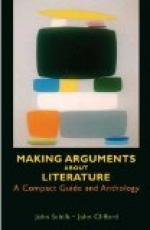2. Conviction and Persuasion. This active purpose of making other people take your view of the case in hand, then, is the distinguishing essence of argument. To accomplish this purpose you have two tools or weapons, or perhaps one should say two sides to the same weapon, conviction and persuasion. In an argument you aim in the first place to make clear to your audience that your view of the case is the truer or sounder, or your proposal the more expedient; and in most arguments you aim also so to touch the practical or moral feelings of your readers as to make them more or less warm partisans of your view. If you are trying to make some one see that the shape of the hills in New England is due to glacial action, you never think of his feelings; here any attempt at persuading him, as distinguished from convincing him, would be an impertinence. On the other hand, it would be a waste of breath to convince a man that the rascals ought to be turned out, if he will not on election day take the trouble to go out and vote; unless you have effectively stirred his feelings as well as convinced his reason you have gained nothing. In the latter case your argument would be almost wholly persuasive, in the former almost wholly a matter of convincing.
These two sides of argument correspond to two great faculties of the human mind, thought and feeling, and to the two ways in which, under the guidance of thought and feeling, mankind reacts to experience. As we pass through life our actions and our interest in the people and things we meet are fixed in the first place by the spontaneous movements of feeling, and in the second place, and constantly more so as we grow older, by our reasoning powers. Even the most intentionally dry of philosophers has his prejudices, perhaps against competitive sports or against efficiency as a chief test of good citizenship; and after childhood the most wayward of artists has some general principles to guide him along his primrose path. The actions of all men are the resultant of these two forces of feeling and reason. Since in most cases where we are arguing we have an eye to influencing action, we must keep both the forces in mind as possible means to our end.
3. Argument neither Contentiousness nor Dispute. Argument is not contentiousness, nor is it the good-natured and sociable disputation in which we occupy a good deal of time with our friends. The difference is that in neither contentiousness nor in kindly dispute do we expect, or intend, to get anywhere. There are many political speeches whose only object is to make things uncomfortable for the other side, and some speeches in college or school debates intended merely to trip up the other side; and neither type helps to clear up the subjects it deals with. On the other hand, we spend many a pleasant evening arguing whether science is more important in education than literature, or whether it is better to spend the summer at the seashore or in the mountains, or similar subjects, where we know that everybody will stand at the end just where he stood at the beginning. Here our real purpose is not to change any one’s views so much as it is to exchange thoughts and likings with some one we know and care for. The purpose of argument, as we shall understand the word here, is to convince or persuade some one.




